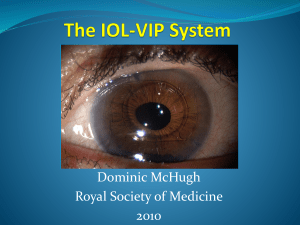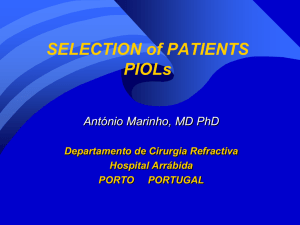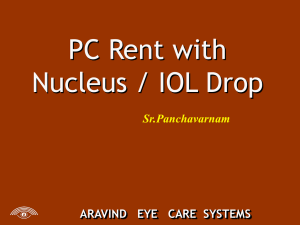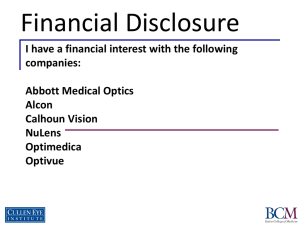( Alcon) IOL in babies
advertisement
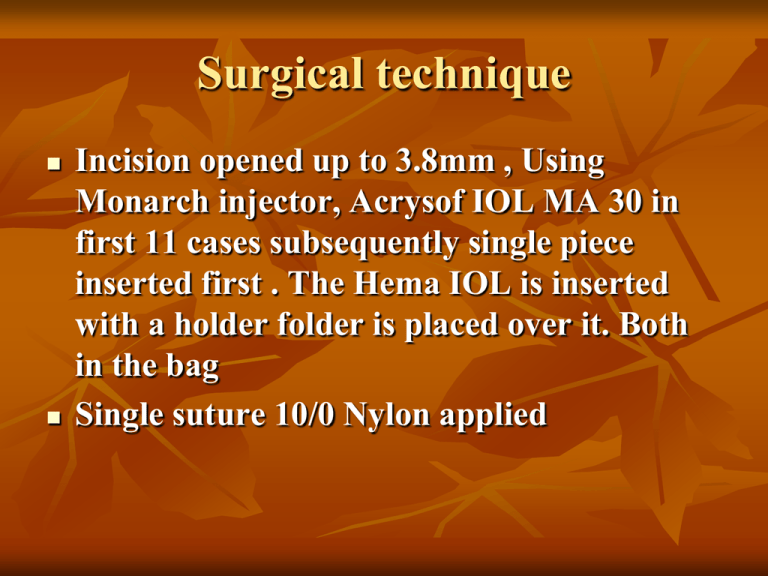
Surgical technique Incision opened up to 3.8mm , Using Monarch injector, Acrysof IOL MA 30 in first 11 cases subsequently single piece inserted first . The Hema IOL is inserted with a holder folder is placed over it. Both in the bag Single suture 10/0 Nylon applied Intraocular Implants using Bagged Disc Hema with Acrysof ( Alcon) IOL in babies 9 month child with gradual fall in vision. Intraocular Implants using Bagged Disc Hema with Acrysof( Alcon) IOL in babies Side port with MVR blade, supporting from the opposite side Intraocular Implants using Bagged Disc Hema with Acrysof( Alcon) IOL in babies Diamond knife tunnel corneal incision . Care to make a deep tunnel . Intraocular Implants using Bagged Disc Hema with Acrysof( Alcon) IOL in babies Rhexis commenced with sharp pointed Utrata forceps Intraocular Implants using Bagged Disc Hema with Acrysof( Alcon) IOL in babies Hydrodissection with blunt cannula Intraocular Implants using Bagged Disc Hema with Acrysof( Alcon) IOL in babies Phaco with high aspiration , occasional pulse Intraocular Implants using Bagged Disc Hema with Acrysof( Alcon) IOL in babies Fragments aspirated out carefully . Note edge of rhexis Intraocular Implants using Bagged Disc Hema with Acrysof( Alcon) IOL in babies Final fragments aspirated out. Intraocular Implants using Bagged Disc Hema with Acrysof( Alcon) IOL in babies Posterior rhexis with the Utrata forceps Intraocular Implants using Bagged Disc Hema with Acrysof( Alcon) IOL in babies Posterior rhexis completed Intraocular Implants using Bagged Disc Hema with Acrysof( Alcon) IOL in babies Incision widened to 3.8 mm using a keratome. Note width of tunnel Intraocular Implants using Bagged Disc Hema with Acrysof( Alcon) IOL in babies Acrysof lens prepared for injection insertion Intraocular Implants using Bagged Disc Hema with Acrysof( Alcon) IOL in babies Loading lens in the Monarch injector cartridge Intraocular Implants using Bagged Disc Hema with Acrysof( Alcon) IOL in babies Acrysof lens being injected into the posterior chamber Intraocular Implants using Bagged Disc Hema with Acrysof( Alcon) IOL in babies Note Acrysof lens going below the rhexis , into the bag. Care to be taken that it does not snag on the edge of the posterior rhexis Intraocular Implants using Bagged Disc Hema with Acrysof( Alcon) IOL in babies Acrysof lens in place Intraocular Implants using Bagged Disc Hema with Acrysof( Alcon) IOL in babies Hema domed IOL implant . 9.5 mm in diameter, 5.00 mm optics, periphery very thin . Note bevel on edge to permit easy insertion. Intraocular Implants using Bagged Disc Hema with Acrysof( Alcon) IOL in babies Lens placed in the folder to permit easy holding . The lens is folded on itself like a roll in the folder. Intraocular Implants using Bagged Disc Hema with Acrysof( Alcon) IOL in babies Hema IOL inserted into the chamber , note its rolled state Intraocular Implants using Bagged Disc Hema with Acrysof( Alcon) IOL in babies Hema lens opening up. Care must be taken to insert the rim under the iris edge and under the rhexis Intraocular Implants using Bagged Disc Hema with Acrysof( Alcon) IOL in babies Lens is tyre ironed under the rhexis rim and gradually worked into the position. It goes in surprisingly easily due to the edge bevel Intraocular Implants using Bagged Disc Hema with Acrysof( Alcon) IOL in babies Final edge is slipped in Intraocular Implants using Bagged Disc Hema with Acrysof( Alcon) IOL in babies It’s a very easy procedure. Both IOL’s are stable. Thanks to the beveled edge of the IOL, insertion under the rhexis is easy. Unilateral or bilateral cataract Children 16 Number Unilateral 5 Percentage Number Bilateral Percenta ge 31.25% 11 68.75% Age at Implantation Age at Implantation 2 months Number Males Females 5 4 1 3 months 3 1 2 5 months 4 3 1 7 months 5 3 2 8 months 5 1 4 10 months 3 3 0 13 months 1 0 1 15 months 1 1 0 TOTAL 27 16 11 Age at Explantation of the Hema IOL Age at Hema Explantation Number % 18 months 3 11.1 22 months 4 14.8 25 months 6 22.2 28 months 14 51.9 Total 27 100 Residual ametropia after removal of Hema IOL Residual ametropia No % +/- 0.50 3 4 6 0 3 5 4 1 3 1 1 9.7 12.9 19.4 00.0 9.7 16.1 12.9 3.2 9.7 3.2 3.2 +/- 1.00 +/- 1.50 +/- 2.00 +/- 2.50 +/- 3.00 +/- 3.50 +/- 4.00 +/- 4.50 - 5.50 - 7.00 Complications n =27 Complications Number Percentage Corneal abrasion 2 7.4 Shallow A/C 9 33.3 Iritis 6 22.2 Hema IOL Pupil capture Raised IOP : Temporary 2 7.4 7 25.9 Raised IOP : Needed Surgery Hyphema 3 11.1 5 18.5 Criteria for selection of IOL Under anesthesia, measure corneal curvature with auto keratometer on table. Take axial length reading with A- Scan , using SRK –T formula , calculate IOL power. Extrapolate to age of two years based on reading ( a baby at 3 months , with an IOL power of 28 –30 D will be 23 D at 2 years). Place the anticipated IOL power as Acrysof in the bag first, place the residue as Hema over it. Choice of Location 1. 2. 3. Primary posterior chamber IOL's have been placed in the bag and in the sulcus with good success. Secondary posterior chamber IOL's may be placed in the sulcus if the residual capsular leaflets offer sufficient support for the IOL. Some dissection may be necessary to recreate the sulcus in these cases. Sutured posterior chamber IOL's have been used if capsular support is inadequate, but the long-term safety of these lenses is uncertain Why No A/C IOL in a child A/C IOL's are to be avoided at all costs because of intense postoperative inflammatory reaction, risk of angle fibrosis and glaucoma, corneal decomposition, changing dimensions of the angle in the growing child. If a secondary IOL is sought with no capsular support, an PC IOL's should and must be sutured in place. Criteria for removal of IOL When anticipated IOL refraction reaches –4.00 , remove IOL. Example. Baby placed IOL at 3 months of 31 D , 23.00D as Acrysof , + 6 D as Hema ( under correcting by 20%). Will reach – 4.00 at age of 18 months when IOL removed. We use the rule of 4 as a variation of 4 dioptres from emetropia rarely induces significant amblyopia. * * ( Isenberg S. Torczynski E:Mosby 2nd Ed 36-50 Eye in Infancy 1994 ) Summary The Hema domed IOL gives a format which is easy to insert, stable in the eye, very quiet in the eye & induces no adhesions . It is easy to insert via 3.4 mm incision and just as easy to remove without cutting or splitting it. The concept of multiple IOL with phased removal is a concept which is feasible thus giving the best hope for controlling deprivation amblyopia in infants .
